At Gold Nugget Coins, your education about your collection, whether selling or buying, is very important. The history of American numismatics provides an overview of the coins and currency of the United States and other popular countries. If at any time you have a question, please call or email us and we will do everything to answer it honestly.
A HISTORY OF U.S. COINS
COLONIAL AND POST-COLONIAL COINS
“Money had a rich history in America prior to the advent of the United States’ national coinage in 1793. When coins tumbled off the presses from the first U.S. Mint the country was much more accustomed to coins from other countries. People were content to use currency, both old and new, whose values was based more on the metal content than on the issuer’s reliability. Foreign money in America diring the colonial period had become so embedded that it continued to be accepted as legal tender until discontinued by law in 1857. Coins of this era are so fundamental to American numismatics that every collection should include at least a sampling.”
— The Official Red Book, A Guide Book of United States Coins.
THE FIRST UNITED STATE MINT
The Coinage Act of 1792 established the United States Mint and regulated the coinage of the United States. The act created coins in the denominations of Half Cent (1/200 of a dollar), Cent (1/100 of a dollar, or a cent), Half Dime (also known as a half disme) (five cents), Dime (also known as a disme) (10 cents), Quarter (25 cents), Half Dollar (50 cents), Dollar, Quarter Eagle ($2.50), Half Eagle ($5), and Eagle ($10). The first coin minted under the act, and therefore the first official coin of the United States, was the half disme. According to legend these first half disme coins were minted from Martha Washington’s silverware.
FEDERAL ISSUES |
|
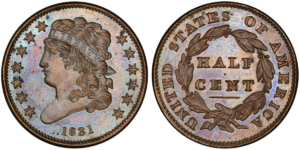 |
The Half Cent (1793 – 1857) Liberty Cap, Head Facing Left (1793) |
|
|
|
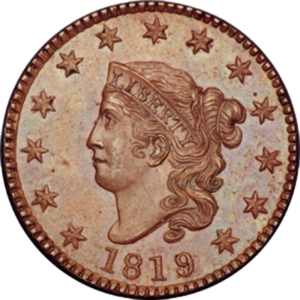 |
The Large Cent (1793 – 1857) Flowing Hair [Chain Reverse] (1793) |
|
|
|
 |
The Small Cent (1856 – to date) Flying Eagle (1856 – 1858) |
|
|
|
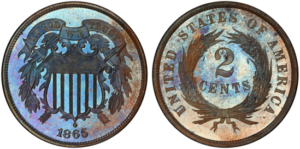 |
The Two Cent piece (1864 – 1873) The two-cent piece was produced by the Mint of the United States for circulation from 1864 to 1872 and for collectors in 1873. Designed by James B. Longacre, there were decreasing mintages each year, as other minor coins such as the nickel proved more popular. |
|
|
|
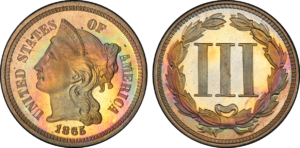 |
The Three Cent piece (1851 – 1889) Silver Three-Cent Pieces (Trimes) (1851 – 1873) |
|
|
|
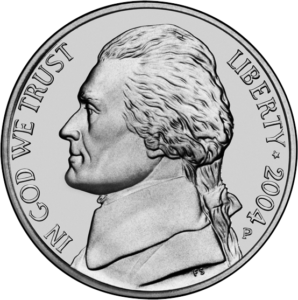 |
The Nickel (1865 – to date) Shield (1866 – 1883) |
|
|
|
 |
The Half Dime (1794 – 1873) Flowing Hair (1794 – 1795) |
|
|
|
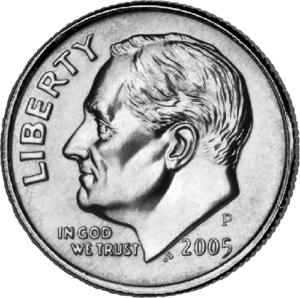 |
The Dime (1796 – to date) Draped Bust (1796 – 1807) |
|
|
|
 |
The Twenty Cent piece (1875 – 1878) Liberty Seated (1875 – 1878) |
|
|
|
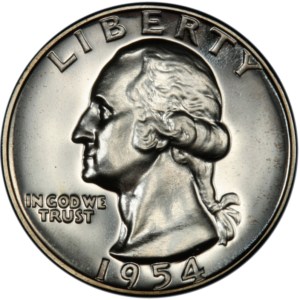 |
The Quarter Dollar (1796 – to date) Draped Bust (1796 – 1807) |
|
|
|
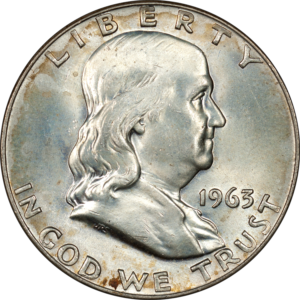 |
The Fifty Cent piece or Half Dollar (1796 – to date) Draped Bust (1796 – 1807) |
|
|
|
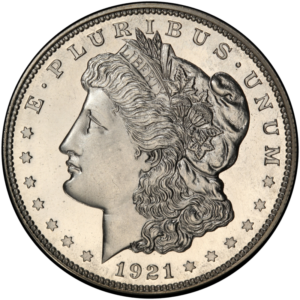 |
The Dollar (1794 – to date)Flowing Hair (1794 – 1795) Draped Bust (1795 – 1804) |
|
|
|
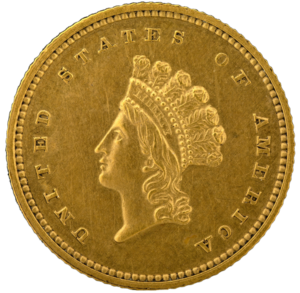 |
The Gold Dollar (1849 – 1889) Liberty Head (1849 – 1854) |
|
|
|
 |
Quarter Eagles [$2.50] (1796 – 1929) Capped Bust to Right (1796 – 1807) |
|
|
|
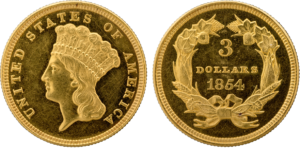 |
Three Dollar Gold Pieces (1854 – 1889) Indian Princess Head (1854 – 1889) |
|
|
|
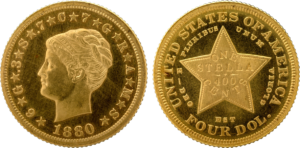 |
The Four Dollar Gold Piece – “Stella” (1879 – 1880) The Stella was a pattern coin produced to explore the possibility of joining the Latin Monetary Union (LMU); these patterns were produced in 1879 and 1880 at the urging of John A. Kasson, a former chairman of the United States House Committee on Coinage, Weights, and Measures. The Stella was meant to contain a quantity of precious metal similar to that of the standard LMU gold piece, the twenty-franc Napoleon minted in France, Switzerland, and other LMU countries. |
|
|
|
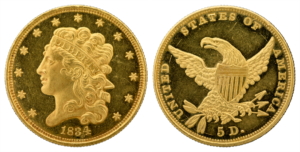 |
Half Eagles [$5] (1795 – 1929) Capped Bust to Right (1795 – 1807) |
|
|
|
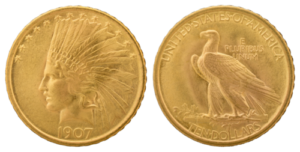 |
Eagles (1795 – 1933) Capped Bust to Right (1795 – 1804) |
|
|
|
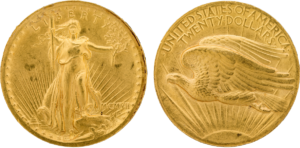 |
Double Eagles (1849 – 1933) Liberty Head (1849 – 1907) |
|
|
|
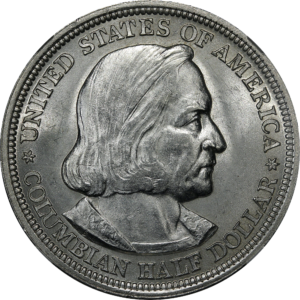 |
Commemorative Coins Commemorative coins have a distinct design to honor the occasion on which they were issued. Many such coins serve as collectors items only, although some countries also issue commemorative coins for regular circulation. Vast numbers of thematic coins are issued, highlighting ancient monuments or sites, historical personalities, endangered species etc. |
|
|
|
 |
Proof Sets – United States Mint Proof coins are special early samples of a coin issue, historically made for checking the dies and for archival purposes, but nowadays often struck in greater numbers specially for coin collectors. Nearly all countries have issued proof coinage. Preparation of a proof striking usually involves polishing of the dies. They can usually be distinguished from normal circulation coins by their sharper rims and design, as well as much smoother “fields” – the blank areas not part of the coin’s design. |
|
|
|
 |
Uncirculated (“Mint”) Sets – United States Mint Starting in 1947 the U.S. mint began producing “mint sets”, and because of the terms used, there is some confusion over the difference between these and proof sets. These are uncirculated coins that have been specially packaged, and are generally neither as expensive nor as valuable as proofs. |
|
|
|
CURRENCY |
|
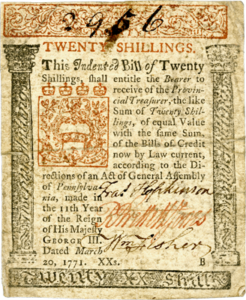 |
Colonial Currency There were three general types of money in the colonies of British America: specie (coins), paper money and commodity money. One by one, colonies began to issue their own paper money to serve as a convenient medium of exchange. The paper bills issued by the colonies were known as “bills of credit.” When the American Revolutionary War began in 1775, all of the rebel colonies, soon to be independent states, issued paper money to pay for military expenses. |
|
|
|
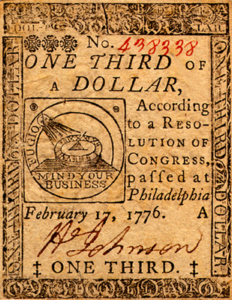 |
Continental Currency After the American Revolutionary War began in 1775, the Continental Congress began issuing paper money known as Continental currency, or Continentals. Continental currency was denominated in dollars from one-sixth of a dollar to $80, including many odd denominations in between. Continental currency depreciated badly during the war, giving rise to the famous phrase “not worth a continental”. A primary problem was that monetary policy was not coordinated between Congress and the states, which continued to issue bills of credit. Another problem was that the British successfully waged economic warfare by counterfeiting Continentals on a large scale. After the collapse of Continental currency, Congress appointed Robert Morris to be Superintendent of Finance of the United States. Morris advocated the creation of the first financial institution chartered by the United States, the Bank of North America, in 1782. The bank was funded in part by specie loaned to the United States by France. |
|
|
|
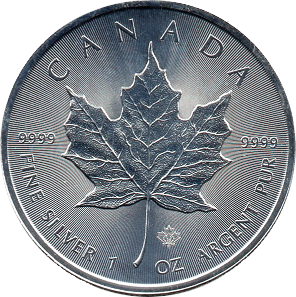 |
Foreign Coins DIA Gold Nugget Coins specializes in United States currency and coins. However, a large number of foreign silver and gold collectibles are also available. Please call or email with specific inquiries. |
| ** Images courtesy of PCGS and Wikipedia |
Historical perspective courtesy of Wikipedia. |
